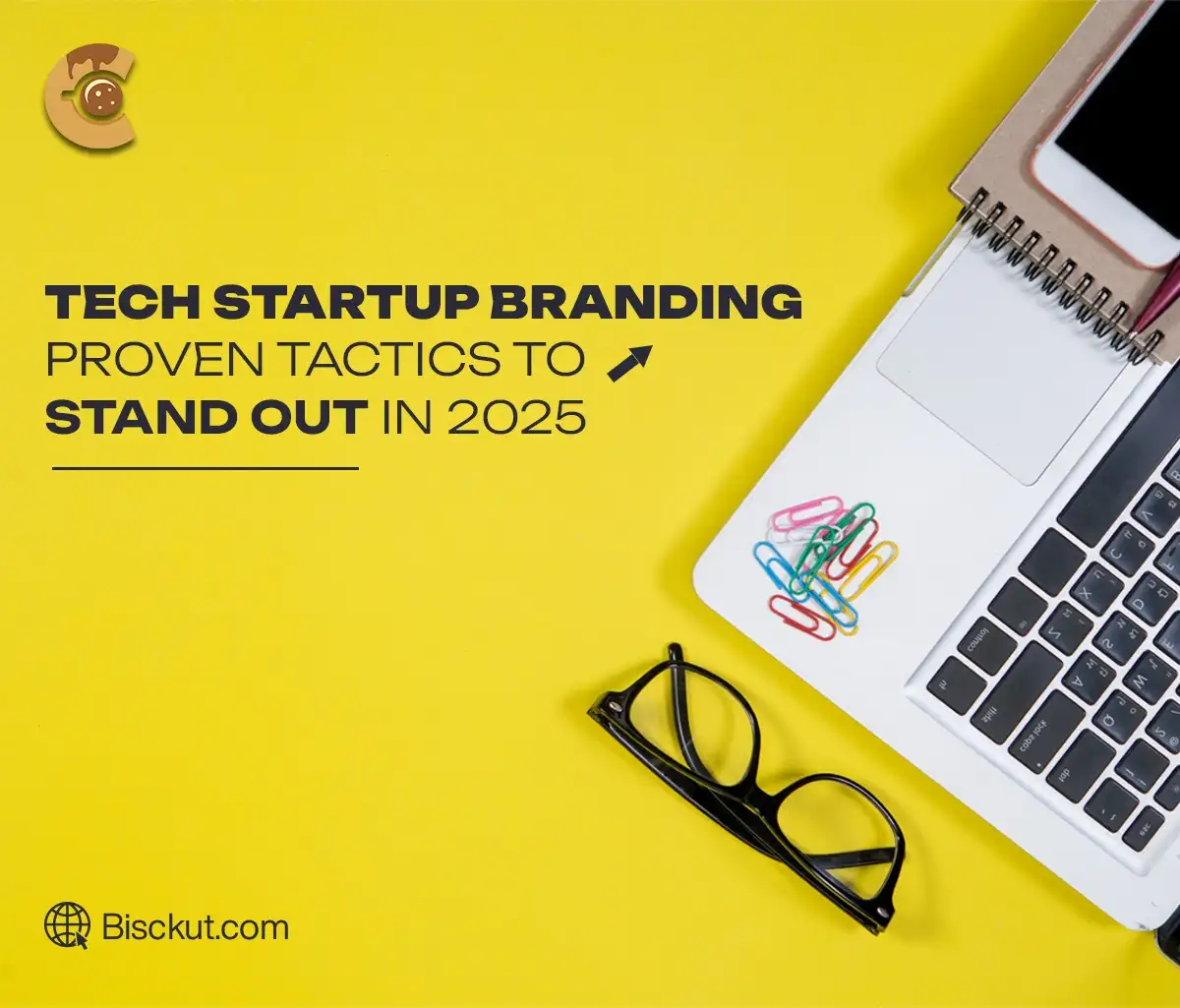In 2025, tech startups will face the difficult challenge of differentiating themselves in a hyper-competitive and saturated market. With the global startup ecosystem growing rapidly, branding has become more than just a visual identity – it’s a strategic tool for survival and growth. For new tech ventures, the right branding approach can help not only attract attention but also build long-lasting customer relationships and trust. Yet, with many startups adopting the same digital tools, offering comparable solutions, and catering to overlapping target audiences, finding ways to cut through the noise is more important than ever.
Tech startups need to think beyond traditional branding strategies and adopt innovative approaches that resonate with their specific audiences, whether they are developers, businesses, or tech-savvy consumers. Building a strong brand in 2025 requires a deep understanding of what makes your product different, a unique value proposition (UVP) that directly addresses customer needs, and a clear, consistent messaging strategy. Additionally, a compelling brand story, visual identity, and customer-centric approach can create key differentiators that build emotional connections and foster consumer loyalty.
By using thoughtful market research, defining their brand’s core identity, and delivering a personalized customer experience, tech startups can carve out a niche and get ahead of their competitors. This article explores the tactics and strategies needed to build a great brand in the tech startup ecosystem, providing actionable insights to help entrepreneurs make their mark in 2025 and beyond.
The Tech Startup Brand Blueprint: A Deep Dive

1. Definition and Purpose
Tech startup branding means establishing a clear, consistent identity that sets your company apart in a competitive marketplace. It’s not just about a logo or a catchy tagline; it’s about shaping the perception of your startup in the minds of your audience, from customers to investors. A strong brand communicates your values, mission, and vision, and aligns every aspect of your business with these core principles.
Startups, especially in the tech space, benefit from building a brand that communicates who they are, what problems they solve, and why their solution matters. This goes beyond just making your business recognizable; it involves setting your mission and values into every touchpoint of your company, from marketing materials to customer service and beyond
2. How Branding Aligns with a Company’s Mission, Vision, and Values
Branding serves as the bridge between your startup’s identity and its audience. It ensures that every interaction, whether it’s through digital platforms, customer support, or product design, reflects the startup’s core mission. The mission, typically defined as the “why” behind the company, guides all actions and decisions. Your vision, which outlines your long-term goals and aspirations, influences your branding by creating a sense of direction. Values provide the foundation, shaping how your startup is perceived in the market.
When aligned correctly, your branding becomes more than just a marketing tool — it becomes an important part of your startup’s culture, building trust and loyalty among customers. It also creates consistency across all channels, making it easier to build a community around your brand and stand out in the crowded tech industry.
This alignment is important because it ensures your branding is authentic, and connects more deeply with consumers, partners, and investors.
Ultimately, a well-defined and well-executed brand helps a startup attract the right audience, clearly communicate its value proposition, and maintain a consistent presence in the market.
3. Why It’s Critical in 2025
In 2025, tech startup branding is more important than ever due to the rapid pace of innovation and an increasingly saturated market. As startups face increasing competition, the pressure to differentiate themselves from competitors becomes immense. A strong, well-executed brand helps businesses not only stand out but also shape customer perception in an environment full of choices.
The constant introduction of new technologies and services has saturated the market, where the number of available options exceeds the attention span of customers. In such an environment, effective branding can significantly impact customer loyalty, trust, and perception of value. It is no longer enough to have a great product; customers want to connect with a brand that fits their needs and values.
Statistics show the undeniable connection between branding and startup success. Studies have shown that startups with strong, consistent brand identities experience higher customer retention and growth rates. For example, consistent branding across multiple touchpoints increases the likelihood of customer engagement by 25%. Furthermore, 63% of customers are more likely to buy from a startup if they recognize its brand, underscoring the importance of brand visibility and consistency in boosting sales and customer trust.
Key Components of an Effective Branding Strategy

As the tech landscape continues to evolve at an unprecedented pace, the need for an engaging and well-structured branding strategy for startups has never been more important. In 2025, it’s not just about having a logo or a catchy tagline. The focus is on developing a brand that resonates with consumers on a more profound level. Below are the key components to consider when building a brand that stands out in the competitive tech space.
1. Brand Purpose and Vision
A tech startup’s brand should go far beyond simply turning a profit. Creating a meaningful purpose that resonates with both internal teams and external customers can create long-term loyalty. The vision should set ambitious goals that inspire action not only among stakeholders but also within the tech community. By establishing a clear brand purpose, startups can differentiate themselves from competitors, creating a lasting impression.
2. Brand Identity
Your brand identity is the first impression customers have of your company. It’s more than just designing a logo – it’s about creating a visual and emotional connection with your audience. Your logo, typography and colour palette should reflect your brand’s values and personality. Consistency is key, so it’s important to maintain a consistent tone of voice across all communication channels. This builds trust and recognition, which is essential for customer loyalty. Companies like Slack and MailChimp are experts at maintaining a consistent brand identity through their visuals and language.
3. Target Audience Analysis
To reach your customers effectively, you need to deeply understand their pain points, preferences, and behaviours. This knowledge enables you to develop products and services that truly resonate with your audience. Techniques such as customer surveys, social media analysis, and engagement metrics help uncover these insights. For example, understanding how your tech product addresses specific needs will enable you to position it effectively in the market.
4. Unique Value Proposition (UVP)
A unique value proposition is what makes your tech startup stand out. It’s important to explain how your product or service solves problems in a way that no one else can. Whether it’s innovation, cost-effectiveness, or unique features, highlighting your UVP can create an emotional connection with your audience. It not only attracts customers but also helps retain them by offering something uniquely valuable.
5. Competitive Positioning
In the bustling technology sector, it is important to differentiate yourself. Competitive positioning involves identifying what makes your brand unique and leveraging it to outperform the competition. Innovation is very important in this sector. By constantly evolving and offering cutting-edge solutions, startups can carve out a niche in the market. Collaborations, co-branding partnerships, and strategic alliances with other influential players in the tech sector can also strengthen your brand’s competitive edge.
Proven Branding Tactics for 2025

In 2025, the branding landscape will continue to evolve, with new strategies gaining prominence as brands seek to connect more deeply with their audiences. These strategies are designed to keep pace with technological advancements and changing consumer expectations.
1. Leveraging AI in Branding
The role of AI in branding is rapidly growing, making more personalized and efficient marketing strategies possible. AI tools are now capable of creating dynamic logos, adjusting visual content in real time, and analyzing customer data to improve marketing approaches. By using AI for logo creation and tailored marketing campaigns, brands can deliver a highly personalized experience that appeals directly to individual preferences. Additionally, AI-powered tools can help brands identify key trends from huge datasets, improving decision-making in product development and customer engagement.
2. Storytelling and Emotional Branding
Storytelling remains an invaluable tool in the branding toolkit. In 2025, emotional branding will take center stage, with brands creating authentic, relatable narratives that create deeper connections with customers. For example, custom illustrations are becoming a key part of this storytelling process, helping brands express personality and build trust through unique visuals.
Brands are increasingly using storytelling to showcase shared values and create emotional bonds between products, strengthening brand loyalty through shared experiences.
3. Sustainability as a Branding Strategy
As consumers become more environmentally conscious, sustainability will become a core component of successful branding strategies. However, it’s not just about making vague sustainability claims – 2025 will see brands using real-time data and customer insights to tailor their sustainability messaging to different audience segments. This means adjusting campaigns based on generational preferences, political views and regional differences to authentically resonate with different groups.
Furthermore, sustainability will move beyond marketing as brands are encouraged to demonstrate real commitment through transparency, showcasing the steps they are taking towards long-term environmental and social impact.
4. Influencer and Community Engagement
Rather than relying on celebrity endorsements, brands are increasingly partnering with micro-influencers and specific communities that share their values. These partnerships foster trust by connecting with consumers on a more personal level, ensuring authenticity in messaging. Additionally, building a community around a brand can help it connect more deeply with its target audience. Interactive online communities and virtual events provide opportunities for customers to share experiences and become brand advocates, building a loyal customer base.
5. Omnichannel Consistency
Ensuring consistency across all customer touchpoints will continue to be critical in 2025. Whether it’s online or face-to-face, your brand’s messaging, tone, and visuals should be consistent. Consumers expect a similar experience whether they interact with your brand on social media, your website, or even in a physical store. Brands that deliver a consistent experience across all channels build stronger relationships with their customers, ensuring that every interaction reinforces the brand’s identity and values.
Common Tech branding challenges

Branding comes with its own set of hurdles, especially when businesses are in the early stages or going through rapid growth. But understanding and tackling these challenges can make a world of difference. Here’s a deeper dive into three key obstacles many face:
1. Budget Constraints
For startups or small businesses, allocating a limited budget to branding can feel overwhelming. However, there are strategies to make impactful branding without spending excessively. Prioritizing essential elements, like brand strategy, logo design, and a website, can help. You might also want to consider scalable branding approaches. For instance, creating a basic logo that can be refined as the business grows or using affordable design tools and templates can save costs. It’s essential to identify what’s most critical in your branding journey and invest where it counts. An effective strategy includes focusing on key touchpoints that resonate with customers, such as online presence, packaging, and messaging.
2. Scaling Without Diluting the Brand
As businesses grow, keeping the brand consistent and authentic can be challenging. It is essential to preserve the core identity while pursuing growth and expansion. During scaling, companies must ensure that their messaging and visual identity align with the evolving audience. For tech startups, for example, it’s important to embrace new technology without losing the foundational values that the brand was built on. A key aspect is being mindful about rebranding at the right time – usually, after significant milestones are reached or once your brand has the financial backing to make that shift. Refreshing your brand without losing its essence can involve the strategic use of modern tools while staying true to the mission.
3. Building Trust in Emerging Markets
Entering new or underserved markets presents a unique challenge—how can you build trust from the start? A key strategy involves localizing your brand, understanding cultural nuances, and crafting messages that resonate with the new market. This requires deep dives into market research, which helps identify needs, preferences, and behaviours. Building credibility involves listening to customers, offering high-quality products, and promoting transparency through clear communication. Sometimes, partnerships with local influencers or respected celebrities can help develop a sense of credibility and build brand loyalty. It’s also essential to reflect the market’s values in your brand messaging, such as emphasizing sustainability in that region if it’s a growing concern.
Tools and Resources for Branding in 2025
In 2025, branding professionals will have access to a number of tools that simplify design, market research, and social media management. Whether you’re a startup or an established business, these tools are essential to staying competitive and managing your brand efficiently.
1. Designing Visual Identities
Tools like Canva and Adobe Express make it easy to create stunning visuals without any hard learning. Canva’s intuitive interface allows you to easily design logos, social media posts, and even presentations, while Adobe Express offers robust features for professional-quality designs and AI-powered recommendations.
2. Market Research and Analytics
Understanding your audience and tracking brand performance is crucial. Tools like Semrush provide in-depth insights into SEO, competitive analysis, and keyword research, which can help refine your content strategy For social media analytics, Buffer is a powerful tool for scheduling posts and gaining insights into engagement, while Panoramiq helps you track competitors and hashtags on Instagram.
3. Social Media and Influencer Marketing Management
Managing multiple social platforms becomes easier with Buffer and Hootsuite. Both tools allow you to schedule posts, monitor engagement, and analyze your social media performance across various channels. If influencer marketing is part of your strategy, platforms like Statsocial offer valuable data for targeting the right influencers and assessing audience interests.
The Real Metrics of Branding Success

To measure the success of your brand in 2025, you should be tracking several key metrics to measure your branding efforts and understand their impact:
1. Brand Recognition and Recall
These metrics measure how well your target audience can recognize and remember your brand. Tools like surveys can help track consumer recall and preference, which can also provide insight into how well your brand connects with your audience.
2. Customer Acquisition Cost (CAC) and Lifetime Value (LTV)
CAC measures the total cost of acquiring a customer, while LTV reflects the total profit you generate from a customer during their relationship with your brand. Both metrics are critical for evaluating the sustainability of your branding efforts. For a healthy business, the LTV to CAC ratio should ideally be around 4:1, meaning your customers should generate four times the cost of acquiring them.
3. Social Media Engagement Rates
Social media is one of the most effective ways to track brand success. Engagement rates—including likes, shares, comments, and click-through rates—help you understand how your audience interacts with your content. Tools like Google Analytics, social listening tools, and platform-specific insights (e.g., Facebook Insights, Twitter Analytics) can provide detailed information about your brand’s performance across different channels.
The Future of Tech Startup Branding

As we move into 2025, the future of tech startup branding will be significantly shaped by emerging technologies and trends. Key developments include:
1. AR/VR Integration
Augmented Reality (AR) and Virtual Reality (VR) are revolutionizing branding by offering immersive, interactive experiences. These technologies allow brands to create virtual environments where customers can interact with products and services in unique ways. For example, VR can be used to host virtual brand activations or create virtual showrooms, while AR can enhance physical products by providing extra layers of information or experiences through smartphones.
2. Hyper-Personalization
The demand for highly customized consumer experiences is growing. Through AI and data analytics, startups can provide content, products, and services that feel personalized to individual users. This can mean personalized marketing campaigns, custom recommendations, and even products that adapt to customer preferences in real time. Since consumers expect brands to understand their unique needs, this hyper-personalization will be the cornerstone of effective branding.
To stay ahead of the competition, tech startups will need to continue embracing these emerging technologies while also focusing on sustainability, ethical branding, and transparent communication. Brands that prioritize innovation, authenticity, and personalized customer experiences will be best positioned to thrive in this rapidly evolving landscape.
Conclusion
Branding plays an indispensable role in moving a tech startup forward, especially in a dynamic and competitive market like 2025. It’s not just about logos or taglines; effective branding lays the foundation for building trust, creating emotional connections with customers, and standing out in a saturated market. With a clear, compelling brand purpose and consistent messaging, startups can establish themselves as leaders, attract the right customers, and drive long-term growth.
As the market continues to evolve with new technologies and changing consumer expectations, tech startups must adopt and refine actionable branding strategies. Embracing innovation, focusing on customer personalization, and maintaining brand consistency across all touchpoints will ensure startups stay relevant and competitive.
By remaining consistent, adapting to emerging trends, and committing to authentic storytelling, tech startups can build strong, lasting brands that stand the test of time.








